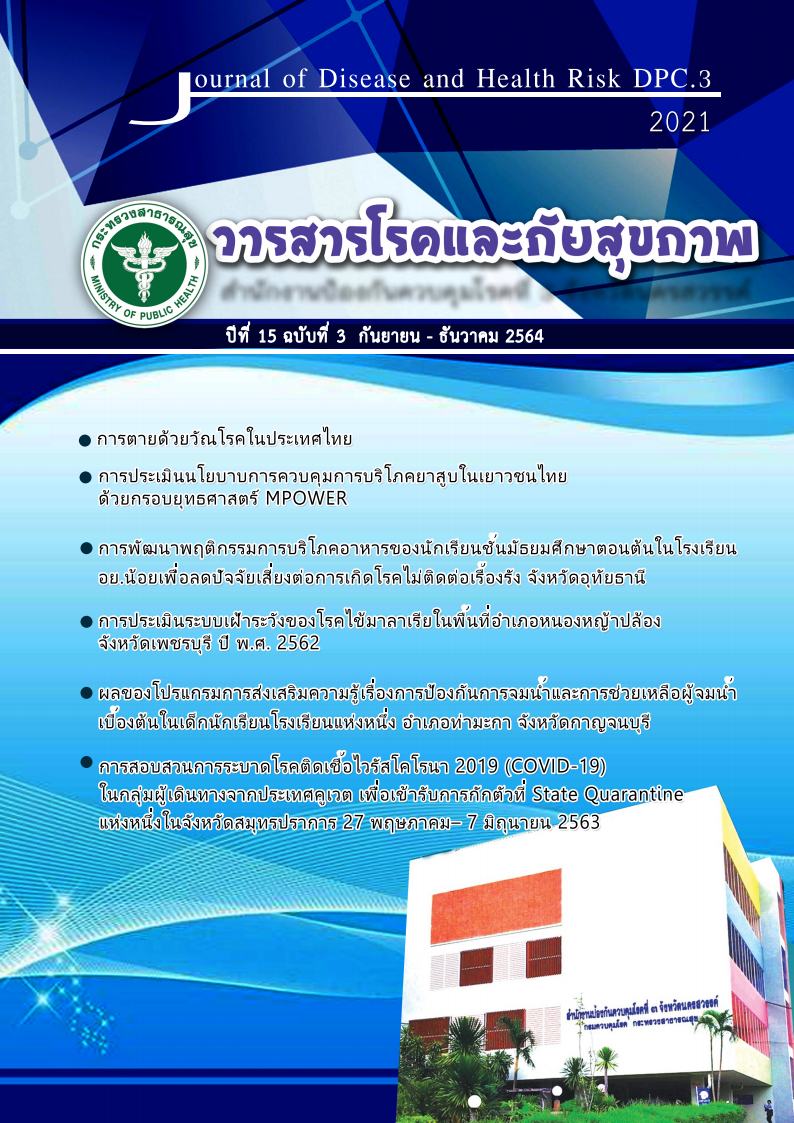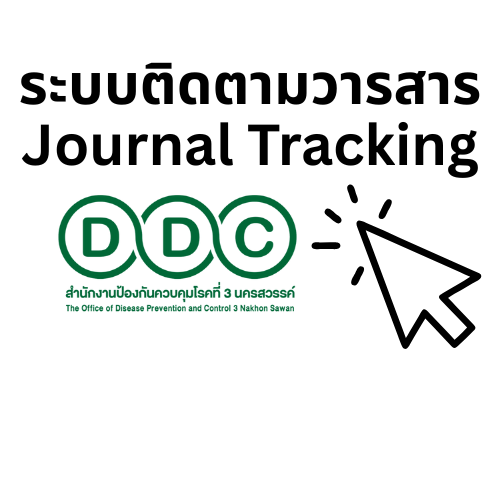The development of food consumption behavior in junior high school students in Oryornoi school network for reducing risk factors in non-communicable diseases in Uthaithani province
Keywords:
Oryor noi, Food consumption behavior, Non communicable diseases (NCDs)Abstract
The objectives of this action research are to study the methods and the results of improving food consumption behaviors of junior high school students in Oryornoi network in order to reduce risk factors of non-communicable diseases in Uthaithani Province. The 339 samples who studied in grade 7 from 13 Oryornoi schools that had passed the standard of Uthaithani Provincial Public Health Office selected by systematic sampling random by teachers of Oryornoi school. The data were analyzed by descriptive statistics and Pair sample t-test. The results of the methods showed that 5 items; 1) Reviewing Oryornoi performance in the past, 2) Selection the Oryornoi schools, 3) Improving schools to be potential 4) the 13 schools improved themselves by Food and Drug Administration model and 5) Monitoring and Evaluation the performances. The results of improving food consumption behaviors showed that, the samples had gained more knowledge and most of them had better food consumption behaviors to reduce risk factors of non-communicable diseases at 0.05 significance level and most of them were highly satisfied in the participatory of this project.
References
กรมควบคุมโรคไม่ติดต่อ.รายงานสถานการณ์โรค NCDsเบาหวาน ความดันโลหิตสูงและปัจจัยเสี่ยงที่เกี่ยวข้องพ.ศ.2562.[อินเทอร์เน็ต].2563[เข้าถึงเมื่อ11เม.ย.2564].เข้าถึงได้จาก: https://bit.ly/3mp5apy
สำนักงานพัฒนานโยบายสุขภาพระหว่างประเทศ. รายงานภาระโรคและการบาดเจ็บของประชากรไทย พ.ศ. 2557. [อินเทอร์เน็ต]. 2560 [เข้าถึงเมื่อ 17 ต.ค.2563]. เข้าถึงได้จาก: https://bit.ly/3Bj7y7x
กรมควบคุมโรคไม่ติดต่อ. สถานการณ์การดำเนินงานด้านการป้องกันควบคุมโรคไม่ติดต่อ (NCDs). [อินเทอร์เน็ต]. 2561 [เข้าถึงเมื่อ 11 เม.ย.2564]. เข้าถึงได้จาก: https://bit.ly/3oGbEDm
สำนักงานสถิติแห่งชาติ. สำรวจพฤติกรรมการบริโภคอาหารของประชากร พ.ศ. 2560. [อินเทอร์เน็ต]. 2560 [เข้าถึงเมื่อ 11 ส.ค.2563]. เข้าถึงได้จาก: https://bit.ly/2Ypgf24
World Health Organization. 10 facts on noncommunicable diseases. [Internet].2013 [cited 2020 Aug 11]. Available from: https://www.who.int/features/factfiles/noncommunicable_diseases/en/
วีระชัย นลวชัย, ศิริกุล อาพนธ์, กรัณฑรัตน์ บุญช่วยธนาสิทธิ์, จินตนา เทียมทิพร, จุฬารัตน์ นิพนธ์แก้ว. การพัฒนาพฤติกรรมการบริโภคอาหารของนักเรียนในโรงเรียน อย.น้อย เพื่อลดปัจจัยเสี่ยงต่อโรคไม่ติดต่อเรื้อรัง (NCDs). [อินเทอร์เน็ต]. 2560 [เข้าถึงเมื่อ 11 ส.ค.2563]. เข้าถึงได้จาก: http://www.oryornoi.com/?p =4822
ชัชวาลย์ เผ่าเพ็ง,สุลัดดา พงษ์อุทธา, สุพล ลิมวัฒนานนท์, จุฬาภรณ์ ลิมวัฒนานนท์, สุรศักดิ์ ไชยสงค์, กัญจนา ติษยาธิคมและคณะ. ความแตกต่างของพฤติกรรมการบริโภคอาหารของประชากรไทย: ลักษณะประชากร เศรษฐกิจและสังคมและสถานะสุขภาพส่งผลอย่างไร. วารสารวิจัยระบบสาธารณสุข. 2560; 11(3): 316-26.
Wayne WD. Biostatistics: A Foundation of Analysis in the Health Sciences. 6th ed. Hoboken: Wiley&Sons inc; 1995.
สำนักงานเขตพื้นที่การศึกษามัธยมศึกษา เขต 42. ข้อมูลจำนวนนักเรียน ปี 2563. [อินเทอร์เน็ต]. 2563 [เข้าถึงเมื่อ 11 ส.ค.2563]. เข้าถึงได้จาก: http://www.secondary42. obec.go.th/
สำนักงานเขตพื้นที่การศึกษาประถมศึกษาอุทัยธานี เขต 1. ข้อมูลพื้นฐาน. [อินเทอร์เน็ต]. 2563 [เข้าถึงเมื่อ 11 ส.ค.2563]. เข้าถึงได้จาก: http://www.utt1.go.th/ about-us
สำนักงานเขตพื้นที่การศึกษาประถมศึกษาอุทัยธานี เขต 2. ข้อมูลพื้นฐาน.[อินเทอร์เน็ต]. 2563 [เข้าถึงเมื่อ 11 ส.ค.2563]. เข้าถึงได้จาก: http://www.utt2.go.th/new/
พัฒนา พรหมณี, ศรีสุรางค์ เอี่ยมสะอาด, ปณิธาน กระสังข์. แนวคิดการสร้างและพัฒนารูปแบบเพื่อใช้ในการดำเนินงานด้านการสาธารณสุขสำหรับนักสาธารณสุข. วารสารสมาคมสถาบันอุดมศึกษาเอกชนแห่งประเทศไทยในพระราชูปถัมภ์สมเด็จพระเทพรัตนราชสุดาฯ สยามบรมราชกุมารี.2560; 6(2): 128-135.
สำนักงานคณะกรรมการอาหารและยา. ประสิทธิผลการจัดกิจกรรมการเรียนรู้เชิงรุกในการส่งเสริมพฤติกรรมเพื่อลดปัจจัยเสี่ยงต่อโรคไม่ติดต่อเรื้อรัง. [อินเทอร์เน็ต]. 2561 [เข้าถึงเมื่อ 11 ส.ค.2563]. เข้าถึงได้จาก: https://bit.ly/3Dm9jkL
จิราภรณ์ เรืองยิ่ง, สุจิตรา จรจิตร, กานดา จันทร์แย้ม. พฤติกรรมการบริโภคอาหารของวัยรุ่นในจังหวัดสงขลา: การสังเคราะห์องค์ความรู้และปัจจัยที่มีอิทธิพลต่อพฤติกรรมการบริโภคอาหาร. วารสารศิลปะศาสตร์ มหาวิทยาลัยสงขลานครินทร์. 2559; 8(1): 245-64.
Downloads
Published
How to Cite
Issue
Section
License
Copyright (c) 2021 Journal of Disease and Health Risk DPC.3

This work is licensed under a Creative Commons Attribution-NonCommercial-NoDerivatives 4.0 International License.
Copyright notice
Article published in the Journal of Disease and Health Risk DPC.3 Nakhon Sawan. It is considered a work of academic research and analysis as well as the personal opinion of the author. It is not the opinion of the Office of Disease Prevention and Control 3, Nakhon Sawan. Or the editorial team in any way Authors are responsible for their articles.
Privacy Policy
Name, address and e-mail address specified in the Journal of Disease and Health Risk DPC.3 Nakhon Sawan. It is used for identification purposes of the journal. And will not be used for any other purpose. Or to another person.









